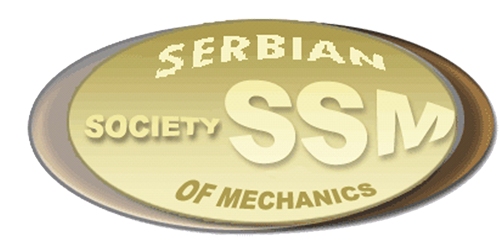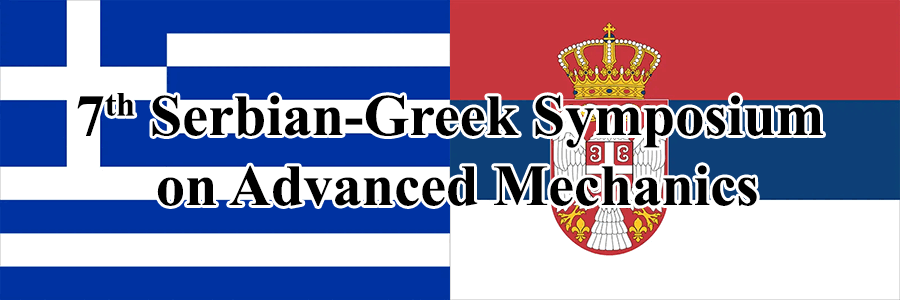9th International Congress of the Serbian Society of Mechanics, July 5-7, 2023, Vrnjačka Banja, Serbia
Invitation and Venue
It is our great pleasure to invite you to the 9th International Congress of the Serbian Society of Mechanics. The Congress will be held in Vrnjačka Banja, Serbia, on July 5-7, 2023. Vrnjačka Banja is a municipality located in the Raška District, Central Serbia, well-known for its hot springs. Vrnjačka Banja is also the most celebrated and most popular spa town of Serbia and, at same time, a very attractive international recreation center.
Objectives
9th International Congress of the Serbian Society of Mechanics aims to bring together leading academic scientists, researchers and research scholars to exchange and share experiences and research results on various aspects of Theoretical and Applied Mechanics. It will bring an interdisciplinary platform for researchers, practitioners and educators to present and discuss the most recent innovations, theories, algorithms, as well as practical challenges encountered and solutions adopted in the fields of Classical Mechanics, Solid and Fluid Mechanics, Computational Mechanics, Biomechanics, Applied Mathematics and Physics, Structural Mechanics and Engineering.
Congress Venue
The 9th International Congress of the Serbian Society of Mechanics will be held at the Hotel Vrnjačke Terme, Vrnjačka Banja.
Accommodation at the hotel can be booked by e-mail prodaja@vrnjacketerme.rs with an e-mail subject – ICSSM 2023 Congress (in order to get a special discount for accommodation as a conference participant).
Important Dates:
- Tentative: Manuscript Submission 20th April, 2023
- Tentative: Manuscript Notification 15th May, 2023
- Tentative: Registration Fee 15th June, 2023
Organizing Committee:
Co-chairs:
- Nenad Filipović, president of SSM (University of Kragujevac)
- Miloš Kojić, (Serbian Academy of Sciences and Arts)
Local Members:
- Dalibor Nikolić, secretary of SSM (University of Kragujevac)
- Miroslav Živković (University of Kragujevac)
- Gordana Jovičić (University of Kragujevac)
- Dragan Rakić (University of Kragujevac)
- Vladimir Dunić (University of Kragujevac)
- Snežana Vulović (University of Kragujevac)
International Scientific Committee:
Adhikari S. (UK), Atanacković T. (Serbia), Atanasovska I. (Serbia), Balean, D. (Turkey), Bauer S. (Russia), Borovac B. (Serbia), Bulatović R. (Montenegro), Carpinteri A. (Italy), Chernousko F. (Russia), Charalambakis N. (Greece), Challamel N. (France), Chen W. (Hohai, China), Chow Ch. (United States), Cvetičanin L. (Serbia), Djordjević V. (Serbia), Dolićanin Ć. (Serbia), Dosaev M. (Russia), Dragović V. (Serbia), Dunić V. (Serbia), Filipović N. (Serbia), Frischmuth K. (Germany), Gajić B. (Serbia), Glavardanov V. (Serbia), Golubović-Bugarski V. (R. Srpska, BiH), Grillo A. (Italy), Hedrih (Stevanović), K. (Serbia), Ibrahimbegović A. (France), Igić T. (Serbia), Jarić J. (Serbia), Jovanović B. (Serbia), Jovanović J. (Germany), Jovičić G. (Serbia), Katsikadelis J. (Greece), Kenjeres S. (Netherlands), Kienzler R. (Germany), Kojić M. (Serbia), Kounadis A. (Greece), Kovačić I. (Serbia), Kozak D. (Croatia), Kraseilnikov P. (Russia), Kuzmanović D. (Serbia), Lacarbonara W. (Italy), Lanusse P. (France), Lazarević M. (Serbia), Marsavina L. (Romania), Melchior P. (France), Malti R. (France), Makris N. (Greece), Maksimović S. (Serbia), Manolis G. (Greece), Manolis P. (Greece), Maretić R. (Serbia), Matthies H. (Germany), Milosavljević D. (Serbia), Mićunović M. (Serbia), Mitrović Z. (Serbia), Müller I. (Germany), Nedeljković M. (Serbia), Nigmatullin R. (Russia), Obradović A. (Serbia), Polyzos D. (Greece), Prokopenya A. (Poland), Rakin M. (Serbia), Rakić D. (Serbia), Rega G. (Italy), Ruggeri T. (Italy), Saccomandi G. (Italy), Schrefler B. (Italy), Sedmak A. (Serbia), Seyranian A. (Russia), Simić S. (Serbia), Shitikova M. (Russia), Spanos P. (USA), Soltakhanov Sh. (Russia), Spasić D.T. (Serbia), Stevanović V. (Serbia), Sun H.G. (Hohai, China), Šumarac D. (Serbia), Terze Z. (Croatia), Tikhonov A. (Russia), Trišović N. (Serbia), Tucker R. (UK), Vignjević R. (UK), Voronkova E. (Russia), Vrcelj Z. (Australia), Vulović S. (Serbia), Zarka J. (France), Zeković D. (Serbia), Živković M. (Serbia), Zorica D. (Serbia)
Plenary Speakers:
- Assoc. Prof. Dr Miha Brojan – University of Ljubljana, Slovenia
Title: From symmetry breaking to functionality: Examples from nonlinear mechanics of beams, plates and shells - Prof. Dr. Dimitri V. Georgievskii – Institute of Mechanics, Lomonosov Moscow State University, Russia
Title: Elements of the Theory of Constitutive Relations and Formulations of the Linearized Problems on Stability - Prof. Dr. Stefano Lenci – Department of Civil and Building Engineering, and Architecture, Polytechnic University of Marche, Ancona, Italy
Title: Nonlinear Wave Propagation in Cables and Beams Resting on a Bilinear Foundation - Prof. Dr. Parviz Moin – Center for Turbulence Research, Stanford University, California, USA
Title: Large Eddy Simulation at Affordable Cost: Application to a Full Aircraft Configuration - Prof. Dr Rafal Rusinek – Lublin University of Technology, Lublin, Poland
Title: Bio-electro-mechanical System of the Human Middle Ear - Assoc. Prof. Dr. Jelena M. Svorcan – Department of Aerospace Engineering, Faculty of Mechanical Engineering, University of Belgrade, Serbia
Title: Numerical Investigation of Flows Around Small-Scale Propellers: Possibilities and Challenges
Assoc. Prof. Dr. Miha Brojan
University of Ljubljana, Slovenia
Title: From symmetry breaking to functionality:
Examples from nonlinear mechanics of beams, plates and shells
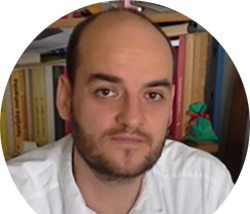
Abstract:
Symmetry breaking is frequently observed in mechanics of structural elements when an equilibrium system transitions from a symmetric phase to a phase with lower energy where the system is at least meta-stable. However, predicting this phenomenon for general problems using current theoretical models and even numerical tools can be rather challenging. A correct description of this process usually requires taking into account significant geometric nonlinearities, a large number of available equilibrium meta-stable states, the possibility of multiple phase transitions (switching between deformation modes), complex equilibrium paths, etc. It should be noted that this is not just of interest to theoretical research; it also has practical implications in engineering. Structural elements such as beams, plates, and shells must be designed according to specific standards to prevent reaching and exceeding critical stresses and strains during operation. Additionally, for slender structures, it is crucial that all parts of the structure remain stable. However, recent studies have been exploring the vast array of deformation patterns and mechanical phenomena that can arise after the loss of stability, particularly in systems that exhibit periodic topography in a deformed configuration. These phenomena can be harnessed to provide advanced functionality using slender structures.
The lecture will cover three examples of symmetry breaking in a highly symmetric structure and transitioning to the supercritical phase by forming periodic patterns. These include:
- a slender beam subjected to torsional deformation,
- a thin two-layer plate with active deformation in one layer,
- a thin hemispherical shell on an elastic substrate subjected to hydrostatic pressure.
In the first example, the critical torsional stress leads to the formation of a helix, the only periodic spatial curve with constant torsion and bending curvature. A theoretical and experimental model of a deformed beam made of extruded polyamide will be presented. This beam has an effectively high negative thermal expansion coefficient due to its geometry and production technology. The second example includes a theoretical and experimental model of a homogeneous deformation of a round composite plate with active deformation in one layer. It will be shown that in the supercritical region the characteristic periodic deformation forms which emanate from the outer edge of the plate are load amplitude dependent. The results are useful in applications of morphing planar structures into preprogrammed three-dimensional objects. The third example is a hemispherical bilayer structure consisting of a thin, stiffer shell and a softer, thicker substrate. Under the influence of hydrostatic pressure, this system loses its stability and forms a surface periodic structure that minimizes mechanical energy by bending and arranging the surface crystal structure. The application of this model has been demonstrated in realizations of smart wetting (to induce super-hydrophobicity/-hydrophilicity), smart bonding, dynamic tuning of aero/hydrodynamic drag, etc.
Biography:
Dr. Miha Brojan is an Associate Professor of Mechanics at the Faculty of Mechanical Engineering, University of Ljubljana. He graduated from the same institution in 2003 and received his Ph.D. degree in 2010. He completed his postdoctoral training at the Massachusetts Institute of Technology – MIT between 2012 and 2013 and in 2016 at Princeton University. For the last two years, he has been working closely with researchers from Princeton University on nonlinear deformations and researchers from UCLA on activation of slender elastic structures based on the loss of stability, transformative structures and the inclusion of artificial intelligence in solving highly nonlinear problems.
Since 2015, he has been principal investigator at the Laboratory for Nonlinear Mechanics (LANEM) at the Faculty of Mechanical Engineering, University of Ljubljana. In recent years, he has been a lecturer on seven subjects, including: Strength of Materials, Thermomechanics, Mechanical Engineering Reporting, Advanced Strength of Materials, Engineering Mechanics 3, Mechanics of Light-weight Structures and Aircraft Flight Mechanics. He is currently mentoring seven undergraduate students, five master’s students and nine doctoral students.
The research he conducts together with his colleagues focuses on the mechanical responses and supercritical stability of slender beams, plates and shells, shape memory materials used in elasto-calorics, viscoelasticity and phase transformations in liquid polymers. They pay special attention to the formation of periodic structures, which are created in e.g. wrinkling of plates and shells, torsion of beams, etc. In doing so, the research group develops (ab initio) theoretical and numerical predictive models and, more recently, precise desktop experiments, which serve to validate the predictive models or to discover new mechanisms of operation of such structures.
Prof. Dr. Dimitri V. Georgievskii
Institute of Mechanics, Lomonosov Moscow State University, Russia
Title: Elements of the Theory of Constitutive Relations and Formulations of the Linearized Problems on Stability
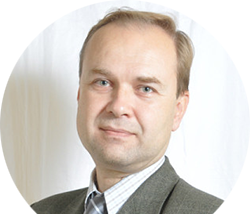
Abstract:
The report consists of three interconnected parts, one way or another concerning the various aspects of continuum mechanics and the theory of constitutive relations. In the first of them, the basic properties of the operators included in the constitutive relations are described and on this basis a certain classification of media is given. In the second part, the apparatus of tensor nonlinear isotropic functions in the theory of constitutive relations in relation to tensor (vector) nonlinear, or quasilinear media, is developed. In the third part, for the environments described in the previous two parts, the formulations of linearized stability boundary-value problems are given in terms of small perturbations of both initial data and material functions.
Elements of the Theory of Constitutive Relations (CR)
- Tangent module and tangent pliability as the inverse tensors of the fourth rank. Bounded above, nonnegative and positive definite tangent modulus. Soft and hard characteristics of material.
- Material functions as the quantities that involve in definitions of the CR-operators and may be determined only in setting experiments.
- Rheonomic and scleronomous media. Aging and ageless materials.
- Homogeneous and nonhomogeneous media. Composites as the media where the CR-operators depends on coordinates by discontinuous way. Layered (laminated, stratified), fibrous and granular composites. Micro- and nanocomposites.
- Elastic solid as the medium where at any time moment the strain tensor and temperature in this time moment are the only independent state parameters.
- Viscous fluid as the medium where at any time moment the strain rate tensor and temperature in this time moment are the only independent state parameters.
- Media with memory. Viscoelastic solid.
- Non-local media. Strong and weak nonlocality.
Isotropic Tensor Functions and Their Invariants in the Theory of Constitutive Relations
- Most general form of the isotropic tensor function in three-dimensional space.
- Media possessing a scalar potential. The conditions of potentiality.
- Incompressible media (fluids). Most general form of the isotropic tensor function in case of incompressibility. Algebraic connection of invariants.
- Nonlinear elastoviscoplastic media in mechanics of continuum and their possible classification. Tensor (vector) CR and scalar CR. Tensor linear (quasilinear) and tensor nonlinear CR.
Formulation of the Boundary-Value Problem in Terms of Perturbations
- The closed systems of linearized equations in terms of perturbations.
- Linearization of constitutive relations.
- Linearization of boundary conditions and their transfer from perturbed boundaries to non-perturbed ones.
- Integral measures evaluating initial and current perturbations. Stability by two measures.
- Stability with respect to perturbations of material functions.
Biography:
Dimitri V. Georgievskii is Professor and head of the Chair of Elasticity Theory at Mechanical and Mathematical Department of the Moscow State University. He is Director of the Institute of Mechanics (MSU), Director of the world-class scientific center “Supersonic-MSU” and professor and expert of the Russian Academy of Sciences. In the period 2014-2015 was a Vice-Rector of the MSU.
The field of the main scientific interests of Prof. Georgievskii includes the following problems:
- Theory of constitutive relations in continuum mechanics. Instrument of tensor functions, Integral representations. Theory of adjusting experiment for obtaining of material functions.
- Phenomenological description of stress-strain state by multiscale simulation.
- Asymptotic methods in theory of thin solids. Deformation of solids with strongly distinguishing sizes.
- Stability of deformation processes in solid mechanics and composite mechanics. The Liapunov – Movchan’ method and its development.
- Hydrodynamic stability of flows with complex rheology. Spectral problems on stability. The generalized Orr – Sommerfeld’ problems. The integral relations methods and energetic (variational) estimates of stability.
- Non-Newtonian and viscoplastic flows. Analytical and numerical solutions. Self-similarity and the Stefan’ problem. Applications in oil industry, biomechanics, geotectonics, glaciology.
- Weak nonhomogeneous flows. Description of transitions to mixing.
- Heavy gravitational non-stable multilayer systems. Dominating waves. Salt diapirism.
- Mechanics of n-dimensional solid and n-dimensional continuum.
He is executive secretary of the Editorial Board of Journal “Vestnik Moskovskogo Universiteta. Ser. 1. Matematika, mekhanika”, Scientific Editor (2006-2014) and the Member of the Editorial Board of Journal “Izvestiya Akademii Nauk. Ser. Mekhanika Tverdogo Tela”. The Member of Editorial Board of Journals “Applied Mathematics and Mathematical Physics”, “Composites and Nanostructures”, “Vestnik MGTU. Ser. Estestvennye nauki”, “Mathematical Modeling and Computational Methods”, “Vestnik ChGPU. Ser. Mekhanika Predelnogo Sostoyaniya”, “Vestnik Udmurtskogo Universiteta. Ser. Matematika. Mekhanika. Komp’yuternye nauki”.
Prof. Georgievskii is author or coauthor of four monographs and textbooks, as well as in more than 250 published papers.
Professor Georgievskii is the member of International Higher Education Academy of Sciences, the Member of the Expert Council in mathematics and mechanics of the Russian High Attestation Committee and the Member of the Expert Council in the Russian Fund for Basic Research. He is Member of the Gesellschaft fur Angewandte Mathematik und Mechanik (GAMM), American Mathematical Society (AMS), International Society for Analysis, its Applications, and Computation (ISAAC).
He is decorated with five medals and prizes for his scientific work.
More information about the teaching and publications on the LINK.
Prof. Dr. Stefano Lenci
Department of Civil and Building Engineering, and Architecture, Polytechnic University of Marche, Ancona, Italy
Title: Nonlinear Wave Propagation in Cables and Beams Resting on a Bilinear Foundation
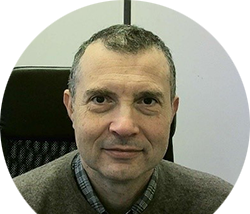
Abstract:
Wave propagation on cable and beams is an old mechanical problem, which is relevant both from theoretical and practical points of view. In the past much has been done, but mainly in the linear realm, even in presence of a (linear) foundation. Much less instead has been developed when there are nonlinearities, and there is still a gap of knowledge in this respect. Various studies are based on numerical simulations, that solve specific problems but do not give an overall understanding of the mechanical behaviour.
In this work I focus on exact mathematical solutions of the nonlinear problem, that are an important to have a full perception of the system characteristic. In the nonlinear realm exact solutions are very few and restricted to particular cases. Fortunately, I found that when the nonlinearity comes from a bilinear foundation, i.e. a substrate that has different stiffnesses in tension and compression, the solution can be obtained analytically.
The obtained solutions are illustrated for the case of cables, beams and nonlocal beams. They have increasing difficulty from a mathematical point of view, and in parallel (and as a consequence, indeed) have more complex and interesting mechanical behaviours.
Biography:
Stefano Lenci researched and taught at the Universities of Ancona (now Polytechnic University of Marche), Camerino, Pisa, Rome “La Sapienza” and Paris 6, where he stayed for two years and half. He was the responsible of various national and international (with UK, Poland, France, Spain, Brazil, Serbia, Germany, China) scientific projects. He was visiting at the Universities of Paris 6, Wien, Montpellier II, London, Aberdeen, Lublin, Extremadura, Sao Paulo, Rio de Janeiro, Hiroshima, Jeddah, Harbin, Nanjing, Lodz, Novi Sad, Hunan University, Sichuan University of Science and Engineering. He was invited to deliver 40+ seminars in different Universities. He supervised more than 200 undergraduated students and 25 PhD students (4 ongoing). He authored about 400 scientific publications, among which 12 books (2 international) and 204 papers on international, peer reviewed, scientific journals with high impact factor. He has been Guest Editor of Special Issues of “Phil. Trans. Royal Soc. London,” “Nonlinear Dynamics,” “Meccanica,” “Int. J. Non-Linear Mech”, “Math. Prob. Eng.”, “Nonlinear Theory and Its Applications (NOLTA)”, “Actuators”, “Chaos”, “Theoretical and Applied Mechanics Letters”. He is member of various scientific organization, national and international, and he is reviewer for 187 international scientific journals and for research projects of various scientific Institutions (Austria, Belgium, Canada, Israel, Japan, Kazakhstan, Poland, Romania, UK, The Netherlands, Horizon 2020). He delivered invited/keynote/plenary lectures in various Conferences, and chair several sessions in international Congresses. He was the Chairman of the XIX Italian Congress of Mechanics, Ancona, Italy, 14-17 september 2009, of the Euromech 541, Senigallia, Italy, 3-6 June 2013, of the IUTAM Symposium “Enolides,” Novi Sad, Serbia, 15-19 July 2018, of the Euromech Symposium n. 603,” Porto, Portugal, 5-7 September 2018. He was the co-organizer of the CISM course “Global Nonlinear Dynamics for Engineering Design and System Safety,” Udine, Italy, 13-17 June 2016.
His research is focused on the investigation of several aspects of the nonlinear dynamics of various mechanical systems and models, including buckled beams, shallow arches, rolling ships, inverted pendulum between lateral walls, mathematical pendulum, rigid block, infinite beams on unilateral soil, frictional impact oscillator, bilayer beams. An original method for controlling the nonlinear dynamics and chaos has been developed and applied to various mechanical systems. The dynamical integrity of mechanical systems has been investigated, too. Other specific research issues include laying of marine pipelines in deep and ultra-deep waters (the J-lay problem), the dynamic of windscreen wiper, various aspects of the mechanical behaviour of interfaces, and mechanical models for detecting elastic and damaged behaviour of composites.
Recently, he has investigated the nonlinear vibrations of non-uniform beams, and the effects of the boundary conditions of the nonlinear oscillations of beams, the isochronous oscillations of nonlinear beams, wave propagation in beams on unilateral soil, and exact solutions for nonlinear oscillators.
List of publications on the LINK.
Prof. Dr. Parviz Moin
Center for Turbulence Research, Stanford University, California, USA
Title: Large Eddy Simulation at Affordable Cost: Application to a Full Aircraft Configuration
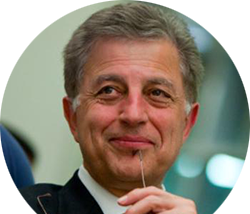
Abstract:
The use of computational fluid dynamics (CFD) for external aerodynamic applications has been a key tool for aircraft design in the modern aerospace industry. In takeoff and landing configurations, predicting the maximum lift an aircraft can produce, and the associated onset of boundary layer separation encountered at high angles of attack is critically important. Flow solutions from state-of-the-art solvers are unable to routinely comply with the stringent accuracy and computational efficiency requirements demanded by industry. In this lecture, I will demonstrate that leveraging large eddy simulation with appropriate wall/subgrid-scale models and low dissipation numerical methods suitable for complex geometries on modern compute architectures offers a tractable path towards meeting these accuracy and affordability requirements.
Biography:
Parviz Moin is the Franklin and Caroline Johnson Professor in the School of Engineering at Stanford University. He is the founding director of the Center for Turbulence Research, CTR, at Stanford University. CTR is widely recognized as the international focal point for turbulence research.
Professor Moin pioneered the use of direct and Large Eddy Simulation techniques for the study of turbulence physics, control and modelling concepts and has written widely on the structure of turbulent shear flows. His current interests include: large eddy simulation of complex flows, multi-phase flows with application to aircraft icing, hypersonic flows, propulsion, computational science, and flow control. He is a co- Editor of the Annual Review of Fluid Mechanics and Associate Editor of Journal of Computational Physics. Professor Moin is a member of the U.S. National Academy of Sciences, and the National Academy of Engineering. He is a Fellow of the American Academy of Arts and Sciences, AIAA and APS.
More information about the teaching and publications on the LINK.
Prof. Dr Rafal Rusinek
Lublin University of Technology, Lublin, Poland
Title: Bio-electro-mechanical System of the Human Middle Ear
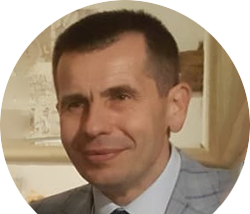
Abstract:
The middle ear is the smallest biomechanical structure in the human body which is responsible for sound transmission from the outer ear canal to the cochlea. Sound approaching the outer ear as an acoustic pressure is transformed first into mechanical vibrations in the middle ear and then into electrical signal in the inner ear. This lecture focuses on sound transfer process through the middle ear in case of healthy and damaged (unhealthy) ear. Analyses are performed using mathematical models and verified experimentally by means of the Laser Doppler Vibrometer on the human temporal bones. The damaged ossicular chain is reconstructed with a new designed shape memory prosthesis or alternatively the ear is provided with an active implant. Both methods of treatments are solved numerically to find better conditions to improve hearing loss and to describe ear dynamics with possible regular and irregular vibrations.
Biography:
Rafal Rusinek educated in Poland, is a head of Biomechanics Department at Lublin University of Technology. His area of research is theoretical and experimental nonlinear dynamics, which he applies to various engineering and biomechanical problems, especially of the middle ear and cutting processes. He has published over 100 journal and conference papers. Rafal Rusinek is the inventor of new patented shape memory prosthesis dedicated for the middle ear and active implant elements. He has established unique experimental laboratory allowing to investigate complex nonlinear dynamic of the middle ear and cutting processes of modern materials.
Assoc. Prof. Dr. Jelena M. Svorcan
Department of Aerospace Engineering, Faculty of Mechanical Engineering, University of Belgrade, Serbia
Title: Numerical Investigation of Flows Around Small-Scale Propellers: Possibilities and Challenges
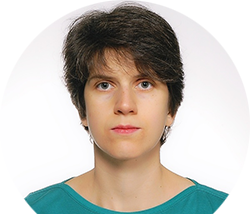
Abstract:
This talk focuses on flows induced by small-scale propeller blades and the wakes shedding from their tips [1-5]. Flows around propellers for unmanned air vehicles (approximately 25-75 cm in diameter) in hover are simulated by different approaches to considering turbulence. The challenges to simulating these kinds of flows mainly arise from the relatively low values of Reynolds numbers (several tens to several hundreds of thousands) when transition and other flow phenomena may be expected. The adopted numerical set-ups are validated though comparisons with available experimental data [6,7]. It can be concluded that global aerodynamic performance can be determined with satisfactory accuracy (the discrepancies between computed and measured values of thrust and torque remain below several percents). However, discerning the actual flow characteristics remains challenging. Here, some distinguishing features of small Re rotational flows are accentuated and discussed. Vortex wakes shedding from the blades are visualized and analyzed. These two benchmark examples provide useful guidelines for further numerical and experimental studies of small-scale propellers.
Biography:
Jelena Svorcan is currently an Associate Professor at the Department of Aerospace Engineering of the University of Belgrade, Faculty of Mechanical Engineering in Belgrade, Serbia where she had also previously obtained her PhD in 2014. She was a Fulbright Visiting Scholar at Stanford University, Center for Turbulence Research from November 2021 till July 2022. Throughout an over a decade-long scientific career, her research has mainly been focused on computational aerodynamics, rotating lifting surfaces, wind energy, turbulence, efficiency improvement, numerical simulations, aircraft design and optimization. So far, Svorcan has participated in several national research projects, mainly focused on fluid flow analysis, composite rotors, and drones, including various collaborations with partners from the industry and has authored or co-authored over 100 scientific publications and technical solutions. Svorcan also continuously performs reviews for international scientific journals. She has prepared and given lectures in 10 different subjects at all three levels of study (BSc, MSc, PhD). Svorcan continuously works with students and younger colleagues-researchers, and so far has guided and taken part in several MSc and PhD theses committees.
Paper Publishing
Only selected full papers will be published after review process in the journals:
- Journal of the Serbian Society for Computational Mechanics
- Theoretical and Applied Mechanics
- Springer Lecture Notes Proceedings
Organizers
- Serbian Society of Mechanics (SSM)
- Faculty of Engineering, University of Kragujevac
- Faculty of Mechanical Engineering, University of Belgrade
- Faculty of Technical Science, University of Novi Sad
- Faculty of Mechanical Engineering, University of Niš
- Hellenic Society of Theoretical and Applied Mechanics
- Institute of Information Technology Kragujevac
- University of Kragujevac
- Mathematical Institute of Serbian Academy of Science and Arts
with the support of - Ministry of Science, Technological Development and Innovation of the Republic of Serbia
- Serbian Academy of Sciences and Arts
and - Serbian Society of Computational Mechanics

Sponsor
Languages
The official language of the Congress is English. The papers and presentations submitted should be written in English.
